Governments seek information superiority and mission assurance – they need real-time operations management, data and information exchange; and morale, welfare, and recreation connectivity for personnel on assignments.
We take this responsibility seriously. That’s why we designed the first enterprise-class Low-Earth Orbit (LEO) network, Telesat Lightspeed, with a focus on three critical components required by enterprise customers, as well as government and defense agencies: security, resiliency and accessibility.
1. Security: Telesat Lightspeed keeps adversaries away.
End-to-end cybersecurity is critical to defense missions, in and moving COMSATCOM and MILSATCOM into a common architecture means the appropriate security standards must be in place.
Telesat’s system architecture and cybersecurity measures established for Telesat Lightspeed present compelling capabilities for government and defense customers. Telesat has adopted the National Institute of Standards and Technology (NIST) Cybersecurity Framework and expects to meet the government standards for Transmission security (TRANSEC) and the Infrastructure Asset Pre-Assessment Program (IA-PRE).
Here are some of the protection elements that Telesat Lightspeed offers:
- Cover: Telesat Lightspeed supports the use of user Layer 2 encryption approaches, including NSA-certified Ethernet Data Encryption.
- Traffic flow security: The Telesat Lightspeed network will include specific features that will improve traffic flow security including masking channel activity.
- Low probability of positioning: The Telesat Lightspeed LEO architecture is designed so information about customer terminal location can remain protected from unauthorized persons.
- Low probability of intercept: The architecture makes in significantly more difficult to intercept communications than for legacy GEO SATCOM solutions. Telesat employs isolated, small, rapidly hopping spot beams; these small beams coupled with multi-satellite access, time-domain access, hopping beams, and the inherent motion of the LEO satellites, significantly increase the complexity of intercepting a wanted signal.
- Jam resistance: Telesat Lightspeed is resilient against jamming attempts because an interferer needs to possess a tracking jamming antenna to follow Telesat Lightspeed LEO satellites, obtain perishable data on specific (narrow) beam usage, and use specific satellite orbital position data. Small beam sizes also complicate an adversary’s ability to interfere from within a specific beam.
- Forward error correction: Telesat Lightspeed radiofrequency transmissions include FEC coding to improve customer cybersecurity.
- CNSSP-12 compliance: Telesat Lightspeed uses NSA-reviewed, NSA-tested, and NSA-approved, CNSSP-12 compliant cryptologic implementations onboard its satellites and operational ground segment to cryptographically secure satellite commands and telemetry to the exacting levels required for critical national security missions.
2. Resiliency: Advantages of Telesat’s LEO technology
Given the importance of government missions, the connectivity technology needs to work wherever it’s used, every time it’s used. These customers need to know that mission-critical data can be transmitted from a terminal back to the command center – and vice versa – in real-time without any outages. Resilient network architectures must be able to mitigate interference, data detection, data interception, and the ability to bypass third-party terrestrial infrastructures to deliver the required connectivity.
Defense organizations need high data rate, low latency, and persistent communications at any point on Earth, including in polar regions.
Government and defense applications are sensitive to latency; Telesat Lightspeed provides less than 50 milliseconds round-trip time latency, resulting in a faster observe-orient-decide-act (OODA) loop decision cycle.
Telesat Lightspeed satellites each have four optical inter-satellite links (OISLs), which create a mesh network in space, resulting in multiple transport routes of user traffic across the space network. A government user can communicate directly from anywhere with the Telesat Lightspeed network constellation satellites and its optical satellite-to-satellite communications path before using a downlink – even on the other side of the Earth.
This eliminates the need to transit a gateway anywhere near a contested or degraded operational environment or to ever use a “non-trusted,” foreign terrestrial network. Embassies, other government facilities, bases, sensors, and weapons platforms will find this particularly valuable.
3. Accessibility: Telesat Lightspeed ahead
User-friendly technologies allow for easier adoption and commercial off-the-shelf (COTS) equipment and standards-based systems allow government customers to access and operate services just as they would access terrestrial infrastructure.
The administrative contracting process also must evolve to increase flexibility in how the government procures commercial satellite communication capabilities. One-year agreements can make it difficult for commercial companies to plan and have the right capacity and capabilities available when they’re needed. Contracting aside, Telesat Lightspeed is a flexible, scalable network that can be accessed anywhere in the world as mission requirements and theaters of operations change.
Government users are increasingly demanding the use of open standards and not being beholden to proprietary standards to avoid “vendor-lock”. Telesat Lightspeed is providing standards-based interfaces to facilitate the use of a variety of terminal solutions using standards-based DVB-S2X and DVB-RCS waveforms and standards-based Metro Ethernet Forum (MEF) Ethernet connectivity
Telesat Lightspeed is built with commercial and security standards in mind and delivers unsurpassed performance, resiliency and assured communications. The multi-use enterprise grade network in conjunction with additional security features delivers a compelling commercial satcom alternative for defense connectivity.
Aeronautical, maritime, enterprise, telecom, government and defense networks can rely on these unique Telesat Lightspeed benefits to take their operations to the next level:
Learn more about how Telesat Lightspeed supports defense applications.




